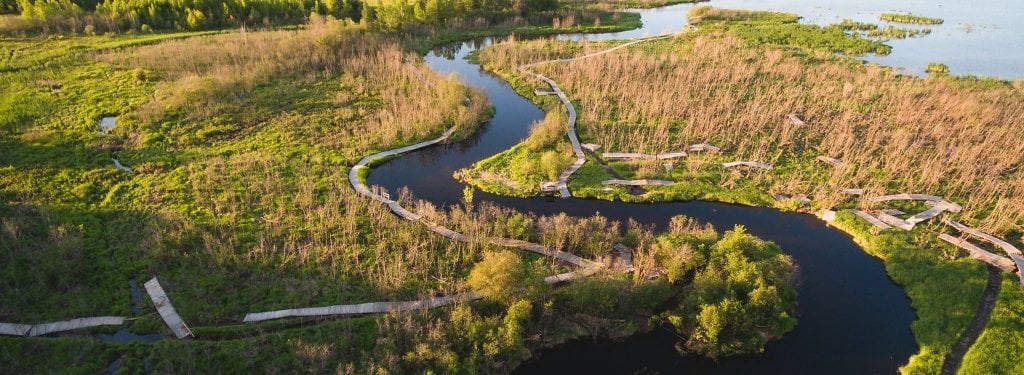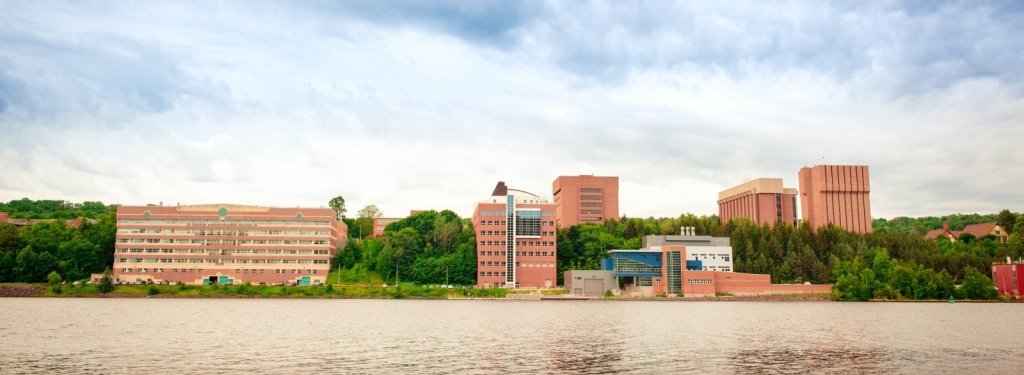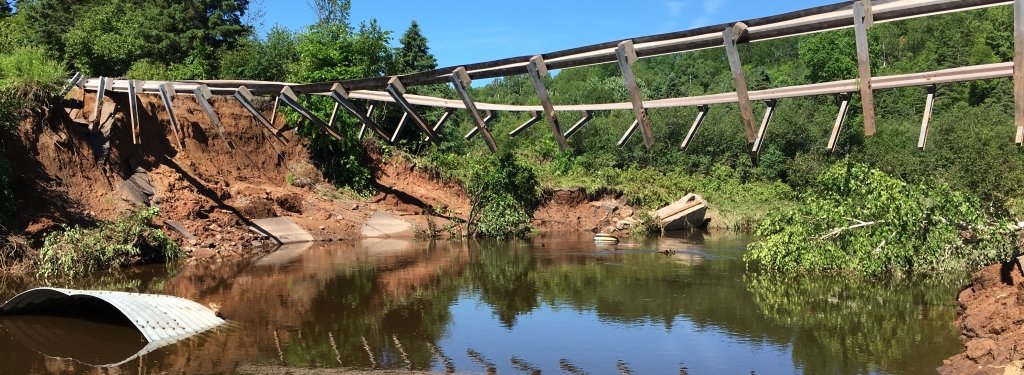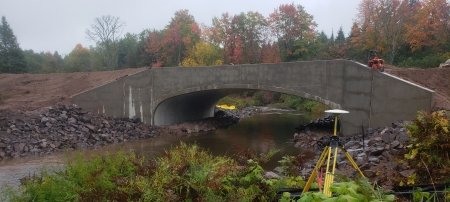Graduate students studying area rivers and streams affected by the way the June 17 flood has changed the landscape.
The waters of the June 17 flood in Houghton County badly damaged homes (some beyond repair), washed out numerous roads, contaminated water bodies and led to the death of a local child. The costs of the damage continue to be assessed and understood.
Yet some costs may go unnoticed; included in that category are the costs to graduate student research projects at Michigan Technological University.
Graduate student researchers occupy a somewhat tenuous position in society—they walk a narrow line between fully fledged researchers and apprentices still learning the ropes. Many do the bulk of the research in labs. Most earn stipends, but not all.
So when the flood waters rose in the county, they buoyed the work of some graduate researchers, providing new data points to analyze. But the flooding severely damaged other projects.
Washed down river
Chris Adams, a doctoral student in biological sciences, studies the migration habits of coaster brook trout—fish sporting yellow and green leopard spots that transition to a golden or deep red belly—from the Pilgrim River in Houghton, Michigan, out to the cold, deep water of Lake Superior. The species is protected in the state of Michigan and its migration habits in the Keweenaw prior to Adams’ study weren’t well known.
Adams and a number of undergraduate students he mentors have placed “pit tags”—tiny radio transmitting chips 23 millimeters, or about half an inch, long—in more than 600 fish in the Pilgrim River. For the past three years, any time a tagged fish swam past four solar-powered antenna stations in the river, the antennae created an electromagnetic field that charges up the tag and sends a 15-digit number signal to a data collecting transducer.
The June 17 flood changed the Pilgrim River and surrounding infrastructure in numerous ways. The U.S. Highway 41 bridge at Nara was damaged. The bridge at Paradise Road washed out and the road remains closed. Three of the four antenna stations were swept down river and into the Keweenaw Waterway. The fish habitat in the river has changed—what were shallow holes are now deep holes, and large trees that were in the river washed away. Adams recovered the Highway 41 station, but it required significant reworking to make it functional again.
“Fortunately, I downloaded the data from them about a week before the storm,” Adams says. “That’s almost more valuable than the antenna stations.”
Adams says between the antenna stations, which each cost approximately $2,000, and the investment of placing the microchips in the fish, it would be a shame for the project to end.
Adams says he hopes to cobble together the funding to replace the antenna stations, whether with help from the local Trout Unlimited chapter, which previously provided project funding, or through other sources.
“I think the project has enough momentum that even when I’m done with my dissertation, it’s likely that it will continue, whether someone else takes it over, or I keep working on it through other means,” he says. “I’ve been sharing this with some of the older folks I’ve met in the community who have been around 70 or 80 years, and they are interested and surprised by what I’ve found out. It’s cool to share this with people who grew up on the river.”
An incredible wealth of data
Kevin Nevorski, a doctoral student in biology, studies nitrogen cycles in streams. He is participating in ecologist Amy Marcarelli’s National Science Foundation-funded CAREER project focused on stream nitrogen fixation and denitrification.
“Seasonally, we know there are large environmental shifts like temperature and light, which shifts biogeochemical cycles (in streams),” Nevorski says. “On a shorter time scale we’re not sure how much these cycles vary, even though some variables that change seasonally can occur on a daily basis. We know environmental variables correlate with changes in biogeochemical cycles, but daily changes, we don’t really know.”

Flooding changes nutrient dynamics, temperature, discharge, oxygenation and other characteristics of streams and rivers. It also provides scientists like Nevorski a chance to study rapid changes in nitrogen cycling. Armed with more than year of baseline data for the Pilgrim River, Nevorski began sampling denitrification, nitrogen fixation and nitrification rates on Tuesday, June 19, just two days after the Father’s Day flood.
“We will be able to see if these rates were altered, if they recover, and their resilience to this huge flood,” Nevorski says. “We’ll be able to see how long it takes to reach baseline or if the flood has changed the baseline.”
Nevorski said based on preliminary sampling the sediment post-flood, the river deposited sand in new locations and scoured many rocks of their algae. Microbes that rely on carbon stored in river sediment and produced by algae have been stripped of their primary food source, which could change denitrification rates.
“I’m sure nutrient dynamics have changed,” Nevorski says. “We can see major changes in the stream channel. There are places where stream banks are now filled with sand, which has changed the morphology of the stream channel. It’s crazy to see these massive changes.”
A landscape altered
Stream research is not limited to the Department of Biological Sciences. Karl Meingast, a doctoral student in forest science, studies the transport of dissolved organic materials from forest soils into streams that empty into Lake Superior, and how the organic materials and microbes affect lakes and streams.

Meingast’s research equipment was on Brooks Creek in the Swedetown area. He had fortunately pulled the data loggers from the gauges to record spring snowmelt data, but the staff gauge and wellhead are gone. The streambank where the wellhead was located is a full foot lower following the flood.
“Streams change. You never know when you’ll have a big snowmelt or pulse to change the stream bed. It’s drastic,” Meingast says. “The way the little creeks blew out, like Brooks Creek, the water must have been like a wall. (In Houghton) at Tech Trails, the creek tore right down to the substrate.”
Research like Meingast’s is important because it studies hydrologic and biogeochemical changes—ephemeral streams and spring creeks can morph from trickles to raging rivers—and its implications for ecosystems.
Another aspect of Meingast’s research is calibrating the color of the stream plumes as recorded by satellite to water quality—specifically organic carbon concentrations and quality. Following the flood, Meingast received satellite optical data of streams from Ontonagon to the Keweenaw Waterway’s north entry.
“The plumes that have emerged from those streams in the days following the flood have surpassed anything I’ve seen from snowmelt,” he says. “With huge flux of nutrients going out to lake, what’s going to happen is an interesting question.”
Challenges and opportunities
Amy Marcarelli, associate professor of biological sciences, says as an environmental scientist, disasters in one’s own community pose a unique set of circumstance.
“Your first thought is safety. Is everyone safe? The next thought is, oh, all the equipment—what have we lost, what’s not working, is the data gone?” she says. “There are challenges and there are opportunities here. For Chris, in particular, this is a big challenge."
Some students enter graduate school knowing they’ll participate in research for a specific project. Others know they want to research, but aren’t necessarily part of a funded project.
“Chris has built that project and monitoring network through his own efforts of grant writing, raising money and building personal connections with Trout Unlimited,” Marcarelli says. “Through his own personal attachment to the river and actions in the community, he built a monitoring network that is now essentially gone. He thinks storms like this might be an important cue to fish about how they move around, and it’s ironic this storm has limited his research.”
On the other hand, for students like Nevorski, the flood presented opportunities to collect critical data for an already funded project.
"We know as ecologists and environmental scientists that extreme events happen. They are part of a natural cycle that is amplified due to climate change. You expect extreme events, even if you never want them to happen to you, to your community, to the place where you live."
“We’re trying to figure out what can we learn from this and what are the consequences for the local ecosystems we’re invested in," Marcarelli says, "but also so we can help people understand and prepare for mega-floods."
Michigan Technological University is an R1 public research university founded in 1885 in Houghton, and is home to nearly 7,500 students from more than 60 countries around the world. Consistently ranked among the best universities in the country for return on investment, Michigan's flagship technological university offers more than 185 undergraduate and graduate degree programs in science and technology, engineering, computing, forestry, business, health professions, humanities, mathematics, social sciences, and the arts. The rural campus is situated just miles from Lake Superior in Michigan's Upper Peninsula, offering year-round opportunities for outdoor adventure.






Comments